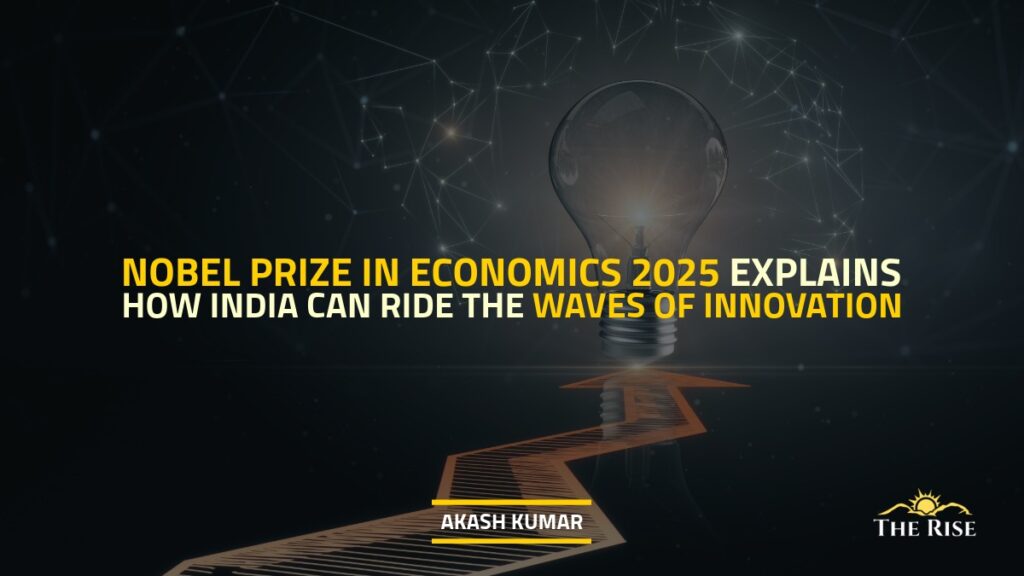The insights of Schumpeter and this year’s Nobel laureates in the field of economic sciences offer a compelling framework for understanding the challenges and opportunities facing India today. The nation’s economic future, its national security, and its societal stability are all intrinsically linked to its ability to embrace and lead in the ongoing technological revolution.
The relentless march of human progress has always been deeply intertwined with the sparks of innovation. Scholars have long debated the precise mechanisms through which new ideas translate into tangible economic growth, a discussion given renewed prominence by this year’s Nobel Prize in Economic Sciences.
The Nobel Prize to Joel Mokyr, for his work identifying the historical prerequisites for technological progress, alongside Philippe Aghion and Peter Howitt, for developing the modern theory of “sustained growth through creative destruction,” brings to the forefront the enduring insights of Joseph Schumpeter, who viewed innovation as the primary driver of economic development. Mokyr’s research illuminates how societal openness to new ideas fuels progress, while Aghion and Howitt mathematically modelled Schumpeter’s concept, showing that economic advancement occurs in disruptive waves as new technologies dismantle the old. This idea of “creative destruction” serves as a powerful lens through which to analyse the contemporary global landscape. For India, a nation at the cusp of a profound transformation, understanding and harnessing this Schumpeterian gale is not merely an academic exercise; it is the foundation of its future economic prosperity, national security, and societal stability.
At its core, innovation is the engine of economic dynamism. As scholars have consistently demonstrated, it is the introduction of new products, processes, and organisational methods that fuels productivity gains, creates new markets, and ultimately drives sustained economic growth. Technology, in this context, acts as the primary catalyst for innovation, providing the tools and platforms for novel ideas to take root and flourish. Schumpeter articulated this precise and intimate relationship between technology and economic expansion. He argued that capitalism’s inherent dynamism stems from a perpetual cycle of innovation that continuously revolutionises the economic structure from within, destroying the old one while creating the new. The work of this year’s laureates has further strengthened this understanding, providing robust empirical evidence and theoretical frameworks that underscore the centrality of innovation in modern economies.
Also Read: Tied by Roots, Driven by Purpose: The Women Entrepreneurs of Nagaland
For India, a nation projected to become the world’s third-largest economy, this scholarly discourse is of paramount importance. The country’s recent economic trajectory has been impressive, but its continued ascent is inextricably linked to its ability to leverage technological advancements, particularly in future-oriented domains. India’s demographic dividend, with a large and youthful population, can only be fully realised if its workforce is equipped with the skills and opportunities presented by emerging technologies. A failure to do so would not only stifle economic growth but also exacerbate social inequalities and potentially lead to instability.
Furthermore, in an increasingly multipolar and competitive world, technological prowess is a direct determinant of a nation’s comprehensive national power. A country’s ability to innovate and deploy cutting-edge technologies has profound implications for its military capabilities, diplomatic influence, and overall standing in the global order. For India, which faces a complex and often challenging geopolitical environment, particularly with a technologically advanced adversary like China, the imperative to achieve self-reliance and even leadership in critical and emerging technologies is a matter of national security. The ongoing global competition for technological supremacy, from semiconductors to artificial intelligence, underscores the strategic significance of this endeavour. India cannot afford to be a mere consumer of technology; it must disrupt or risk being disrupted. India needs to become a creator of technologies.
Also Read: Smart Tools, Unskilled Hands: The Real Barrier in Digital Logistics
This necessitates strategic foresight in developing critical and emerging technologies, enabling India to leapfrog traditional stages of development. Historically, India has demonstrated its capacity for such “leapfrogging,” for instance, by bypassing the landline era and moving directly to a mobile-first digital ecosystem. The same audacious spirit is now required to embrace technologies like artificial intelligence (AI), quantum computing, biotechnology, robotics, and advanced manufacturing. These are not just incremental improvements; they are foundational technologies that will reshape industries, economies, and societies. By strategically investing in research and development (R&D), fostering a vibrant startup ecosystem, and building a world-class talent pool in these areas, India can position itself as a global hub for innovation and secure a competitive edge against adversaries like China, which has made technological dominance a core component of its national strategy.
However, this technological transformation is not without its challenges. The very forces of creative destruction that drive progress can also be deeply disruptive. India’s services sector, a significant contributor to its GDP and a major source of employment, is particularly vulnerable to the transformative power of AI and automation. As highlighted in a recent NITI Aayog report, while AI presents an opportunity to create millions of new jobs, it also threatens routine roles in the crucial technology and customer experience sectors with redundancy. This presents a formidable challenge for policymakers, necessitating the need to navigate this transition with care and foresight.
To mitigate the risks and maximize the opportunities of this technological disruption, a concerted and proactive approach is required from both the central and state governments. The focus must be on creating an environment that fosters innovation while ensuring that the benefits of technological progress are shared widely. This includes substantial investment in education and skilling programs to prepare the workforce for the jobs of the future, such as AI trainers, ethics specialists, and data scientists. It also requires promoting entrepreneurship and the growth of new industries, as well as establishing a robust social safety net to support those displaced by technological change. The goal should not be to resist the tide of technological advancement but to harness its power for the benefit of all citizens.
Also Read: GST Summons versus Proceedings: M/S Armour Security Case Explained
At the heart of this endeavour lies the need for a dynamic, forward-looking, and continuously adaptive Science, Technology, and Innovation (STI) policy. In a world where technoscience is a constantly evolving force, a static policy framework is inadequate. India must move towards a proactive, quinquennial STI policy that is regularly reviewed and updated to reflect the latest technological trends and geopolitical realities. This policy should be an outcome of a collaborative effort between the central government and the states, with active participation from academia, industry, and civil society. It must be ambitious in its scope, outlining a clear vision for India’s technological future and providing a roadmap for achieving it. Key elements of such a policy should include a significant increase in R&D spending, the creation of world-class research institutions, the promotion of public-private partnerships, and the simplification of regulatory frameworks to encourage innovation.
In conclusion, the insights of Schumpeter and this year’s Nobel laureates offer a compelling framework for understanding the challenges and opportunities facing India today. The nation’s economic future, its national security, and its societal stability are all intrinsically linked to its ability to embrace and lead in the ongoing technological revolution. By fostering a culture of innovation, investing in critical and emerging technologies, and implementing a proactive and dynamic STI policy, India can not only navigate the disruptive forces of creative destruction but also harness them to build a more prosperous, secure, and equitable future for all its citizens. The Schumpeterian gale is blowing, and it is up to India to set its sails and ride the winds of change to a brighter tomorrow.
Disclaimer: The views expressed in this article are of the author solely. TheRise.co.in neither endorses nor is responsible for them. Reproducing this content without permission is prohibited.
About the author
Akash Kumar is researcher working at the intersection of Science Technology and International Relations with a focus on critical and emerging technology. He is currently pursuing his PhD in Science Policy Studies from School of Social Sciences, Jawaharlal Nehru University working on India's semiconductor diplomacy.









Innovation is key to India’s rise as a economic power.
Nice Read